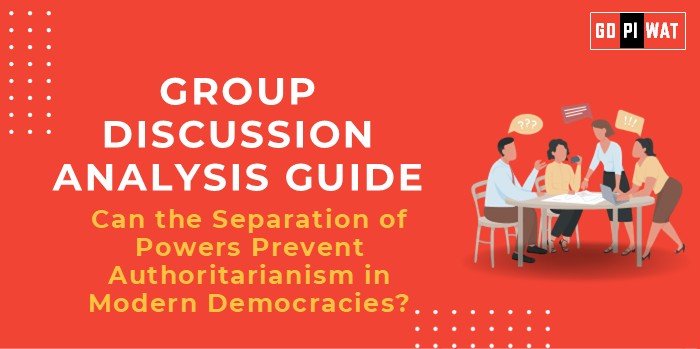📋 Group Discussion Analysis Guide
🌍 Topic: Can the Separation of Powers Prevent Authoritarianism in Modern Democracies?
📖 Introduction to the Topic
Separation of powers, a cornerstone of democratic governance, ensures the balance of legislative, executive, and judicial authority. This principle is increasingly relevant in today’s democracies, which face challenges like populism and centralization of power.
Background: Coined by Montesquieu, the separation of powers aims to prevent any single branch of government from amassing unchecked authority. Despite its global adoption, its effectiveness in curbing authoritarian tendencies remains a topic of intense debate.
📊 Quick Facts and Key Statistics
- Number of Democratic Nations: 96 (Freedom House, 2023) – Reflects the widespread adoption of democratic norms.
- Judicial Independence Index (2023): 4.2/7 globally – Highlights varying adherence to judicial autonomy.
- Press Freedom Ranking: Norway: 28/180 vs. Turkey: 150/180 (RSF, 2023) – Shows the relationship between press freedom and authoritarianism.
- Executive Dominance: 72% of nations saw increased executive influence during the COVID-19 pandemic (World Justice Project, 2023).
👥 Stakeholders and Their Roles
- Government Institutions: Ensure adherence to constitutional checks and balances.
- Judiciaries: Interpret and enforce legal constraints on power.
- Media: Serve as watchdogs against authoritarian drift.
- Civil Society: Advocate for transparency and accountability.
- International Organizations: Provide frameworks for maintaining democratic norms.
✅ Achievements and Challenges
🏆 Achievements:
- Judicial Independence: U.S. Supreme Court rulings, like overturning executive immigration bans, ensure accountability.
- Parliamentary Oversight: Investigative committees curb executive overreach in developed democracies.
- Freedom of Information: Laws such as India’s RTI Act empower citizens to challenge government opacity.
- Global Benchmark: Sweden exemplifies strong separation of powers through decentralized governance.
⚠️ Challenges:
- Executive Overreach: Emergency powers often bypass legislative approval.
- Judicial Undermining: Political appointments erode neutrality (e.g., Poland’s judiciary crisis).
- Media Censorship: Restrictions on free press weaken oversight.
- Comparative Failures: Hungary’s shift toward authoritarianism under Viktor Orbán.
📚 Structured Arguments for Discussion
- Supporting Stance: “The separation of powers acts as a democratic safeguard, ensuring that no branch operates without checks.”
- Opposing Stance: “In practice, power consolidation often circumvents these separations, undermining their theoretical effectiveness.”
- Balanced Perspective: “While separation of powers provides a structural check, its success depends on robust institutions and active civil participation.”
✨ Effective Discussion Approaches
- Opening Approaches:
- “The separation of powers is the backbone of democracy, yet its resilience against modern authoritarianism warrants scrutiny.”
- “Instances of executive overreach highlight the fragility of democratic norms in the absence of institutional independence.”
- Counter-Argument Handling:
- Acknowledge flaws in implementation but propose reforms like stronger judicial autonomy.
- Cite deterrents such as South Africa’s judiciary blocking unconstitutional legislation.
📈 Strategic Analysis: Strengths and Weaknesses
- Strengths: Prevents tyranny, enhances accountability.
- Weaknesses: Susceptible to political manipulation, inconsistent enforcement.
- Opportunities: Strengthen global democratic frameworks.
- Threats: Rising populism, erosion of institutional independence.
🔗 Connecting with B-School Applications
- Real-World Applications: Explore institutional accountability in operations, governance frameworks, and leadership ethics.
- Sample Interview Questions:
- “How does the separation of powers impact corporate governance frameworks?”
- “Can institutional independence inspire better leadership styles?”
- Insights for B-School Students: Understanding how governance impacts economic policies and operational transparency.


